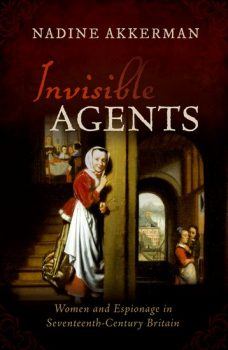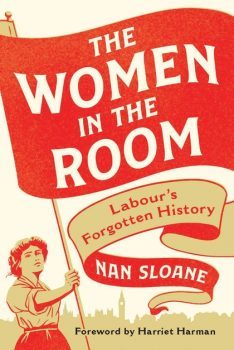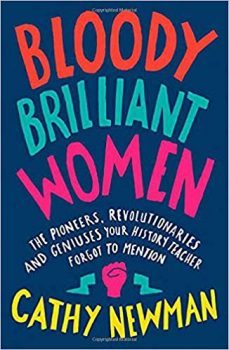by Adele A Wilby
 History has not always been fair to women: their contributions to history have been either marginalised or, not infrequently, unacknowledged. However, the three books, Nadine Akkerman’s (2018) Invisible Agents: Women and Espionage in Seventeenth Century Britain, Nan Sloane’s (2018) The Women in the Room: Labour’s Forgotten History, and Cathy Newman’s (2018) Bloody Brilliant Women, are examples of excellent research and scholarship that documents many women’s contributions to historical events.
History has not always been fair to women: their contributions to history have been either marginalised or, not infrequently, unacknowledged. However, the three books, Nadine Akkerman’s (2018) Invisible Agents: Women and Espionage in Seventeenth Century Britain, Nan Sloane’s (2018) The Women in the Room: Labour’s Forgotten History, and Cathy Newman’s (2018) Bloody Brilliant Women, are examples of excellent research and scholarship that documents many women’s contributions to historical events.
Akkerman’s Invisible Agents is ‘the first full-length study of women’s espionage in seventeenth century Britain…arguably the decades that witnessed a significant increase of female participation in the trade of confidential information.’ Indeed, Akkerman asserts that, ‘female spying activities were at the very heart of British international relations in the mid-seventeenth century’. Her book therefore, has significance for a wider understanding of just how far women were instrumental in shaping the politics of the time.
She focuses on the period 1640s to the 1660s and not without reason; it was a period of political upheaval during the English Civil Wars and the Restoration that spilled over onto the continent where the court of Charles Stuart lived in exile. Inevitably therefore, espionage and counterespionage were important factors in the politics of the era, and female spies were major actors. Akkerman’s work reveals to us the ‘she-intelligencers’ who gathered and exchanged information for either the Royalists, parliamentarians, and indeed, in some instances, for both parties in their capacity as double agents, and were therefore crucial in shaping the political dynamics of the era. Lady d’Aubigny for example, a well-known Royalist, carried information in her hair from King Charles 1 to his friends encouraging them to rise in his support against the parliamentarians in what is known as the Waller plot. She was not the only woman involved in the plot, and she paid the penalty for her work and was eventually imprisoned for her activities. How she escaped execution is not quite clear.
Given that women were considered to be either intellectually or morally incapable of the wile and guile that involving in the intrigue and frequently dirty and duplicitous work of the intelligence operative during seventeenth century, many would question how it came to be that women were able to operate so successfully in such a complicated and indeed, dangerous, context. The answer to that question lies in exactly that; the gender identity of women of that period. Women were able to move in social circles above suspicion where men were not. Thus ‘she-intelligencers’ became not only highly successful in their work, but many, such as Elizabeth Carey, who carried messages between her husband Charles Stuart and others engaged in Royalist plots, thrived in the dangerous circumstances, and, according to Akkerman, enjoyed the adventure.
But while their gender was conducive to their effective engagement as intelligence operatives, it worked counterintuitively and was also responsible for their ‘invisibility’ in the politics and history of intelligence work of the period. Female agents frequently disguised their identity using male names, and male spymasters utilised encrypted language to hide the numbers of women on their books. Cromwell’s intelligence chief Thurloe, for example, coded woman ‘intelligencers’ in his public order books as nurses. Whether this was to protect the women, or, as a man of authority trying to hide his reliance of women for dangerous intelligence work, is a matter that is open to conjecture.
Akkerman provides historical evidence of how ‘she-intelligencers’ were clever, savvy, and prepared to take risks to gather and exchange information in an era of British political upheaval, and in that process defied essentialist gender identities of women as passive and fundamentally nurturers in need of protection. Two hundred and fifty years later gender was both an issue in women’s political participation, and also responsible for their marginalisation in the history of the founding years of the Labour movement in Britain.
 In The Women in the Room, Sloane covers the period from the establishment of the Trades Union Congress in 1868 in Britain until the outbreak of the World War I in 1914 when the war forced an interruption in political activity, and priority was given to the war effort. Her detailed and exhaustive history of women’s engagement in the progressive politics of that period sets the record straight on the depth of their involvement in the politics of the day. Their politics articulated on two issues that have been a source of contention for many women in various struggles throughout the world; feminism and socialism, and this is discernible in the strategy of the suffragettes and the woman socialists. As Sloane comments, ‘the prevalence of one version of the suffrage campaign, together with the use of that campaign as shorthand for women’s rights campaigns generally, has led to the effective erasure of Labour women from most versions of history.’ An example of this can be seen in the strategy for the realisation of female suffrage. Suffragettes Christabel and Emmeline Pankhurst for example, were opposed to socialists campaigning for universal adult suffrage regardless of wealth and status, and preferred the more limited, yet what they considered the more achievable objective, of enfranchising older women with property. Female socialists, Margaret MacDonald, Margaret Bondfield, and Mary Macarthur objected to a suffragette strategy that would leave the poor, both men and women, disenfranchised denying them their right to full political participation. Nevertheless, despite the contradictions in terms of political objectives and strategy, Sloane’s book reveals that women fought for and campaigned on a breadth of issues aimed at improving the lives of women and children, such as infant mortality, public health and free school meals, issues that underpinned the creation of the welfare state in Britain.
In The Women in the Room, Sloane covers the period from the establishment of the Trades Union Congress in 1868 in Britain until the outbreak of the World War I in 1914 when the war forced an interruption in political activity, and priority was given to the war effort. Her detailed and exhaustive history of women’s engagement in the progressive politics of that period sets the record straight on the depth of their involvement in the politics of the day. Their politics articulated on two issues that have been a source of contention for many women in various struggles throughout the world; feminism and socialism, and this is discernible in the strategy of the suffragettes and the woman socialists. As Sloane comments, ‘the prevalence of one version of the suffrage campaign, together with the use of that campaign as shorthand for women’s rights campaigns generally, has led to the effective erasure of Labour women from most versions of history.’ An example of this can be seen in the strategy for the realisation of female suffrage. Suffragettes Christabel and Emmeline Pankhurst for example, were opposed to socialists campaigning for universal adult suffrage regardless of wealth and status, and preferred the more limited, yet what they considered the more achievable objective, of enfranchising older women with property. Female socialists, Margaret MacDonald, Margaret Bondfield, and Mary Macarthur objected to a suffragette strategy that would leave the poor, both men and women, disenfranchised denying them their right to full political participation. Nevertheless, despite the contradictions in terms of political objectives and strategy, Sloane’s book reveals that women fought for and campaigned on a breadth of issues aimed at improving the lives of women and children, such as infant mortality, public health and free school meals, issues that underpinned the creation of the welfare state in Britain.
Women of outstanding organisational and intellectual ability also emerged to leave a political legacy during the early days of the Labour movement in Britain. Margaret Mac Donald, although married to a leader of the Labour Party Ramsay MacDonald, was an experienced statistician with a body of her own work behind her, and a political personality in her own right; just one of many women feminists, socialist and trade union activists in the founding years of the Labour Party.
What becomes apparent throughout the book is the sexism that the women had to engage with and overcome for them to involve with during the founding years of the Labour Party and socialist movements in Britain, and to make contributions towards social policy and politics. Women were always ‘in the room’ during political speeches and discussions during early years of Trade Union and Labour activism, but more frequently in the gallery listening to the discussions of the male heavy weight politicians of the day such as Keir Hardie. Nevertheless, both ability and the determined effort to assert their rights and make their voices heard ultimately resulted in political women earning the recognition they deserved. Isabella Ford and Marion Phillips moved from listening in the seats in the balcony to joining Hardie at conferences and public rallies addressing the audience. Katherine Glasier also became a high-profile speaker who attracted large crowds.
Given the breadth of women’s political activism that Sloane has so painstakingly and brilliantly detailed, it is almost incomprehensible that such a rich history of women’s political engagement in the left-wing politics of the day has previously escaped being written into history. The depth and detail of Sloane’s excellent historical record makes it an invaluable contribution to women’s political history, and a must read for a more thorough and balanced understanding of socialist and Labour politics of the time in Britain.
 And finally, but not least, continuing the theme of recognising women in history is Cathy Newman’s Bloody Brilliant Women.
And finally, but not least, continuing the theme of recognising women in history is Cathy Newman’s Bloody Brilliant Women.
Written in the more journalistic style of Newman’s profession, the book however, is none the less serious. As with both Akkerman and Sloane, Newman’s book is also well researched bringing to the fore women who perhaps might otherwise languish in the dustbin of history, denied the full recognition of their achievements.
Newman divides her book into chapters of periods of history beginning with the late nineteenth century till the 2017, and narrates the stories of remarkable women in each chapter. Newman’s work is therefore, less about discovering women in history as is the case with Akkerman, and deepening the knowledge of women’s participation in politics as in Sloane’s work, and is more a collation of women whose contributions to history have been marginalised. Her broader approach to history works effectively to provide us a range of knowledge on women in different fields of work such as engineering and science. The name Beatrice Shilling is probably unknown in many households and even lesser so in terms of the British war effort. Yet as Newman reveals, Beatrice Shilling, one of a few female aeronautical engineers of the 1940s, played a crucial role in the British defeat of the German Luftwaffe in World War II. When in charge of carburettor research and development work at the Royal Air Force she rectified a flaw in the British planes that was giving the German Luftwaffe the edge over British planes. The success in improving the fighting capacity of the Spitfires and Hurricane planes resulted in the indefinite postponement of Germany’s planned amphibious and airborne invasion of Britain. Yet, as Newman comments, the history books have not accorded Shilling the credit she deserves.
Without Newman’s book on exceptional women, it is unlikely that we would get to know of Rosalind Franklin and her contribution to the discovery of the double helix structure of DNA. However, an injustice was done to Franklin when, without her permission, her colleagues, Maurice Wilkins and Max Perutz, showed her research to DNA model builders Francis Crick and James Watson, who needed her research to prove the DNA’s two-strand structure. She died four years before Crick, Watson and Wilkins were jointly awarded the Nobel Prize.
There are many stories of remarkable women in Newman’s book. The reading of it, as with Akkerman and Sloane’s books, redresses a gender imbalance in our knowledge and understanding of various historical events and eras. Each of these books highlights how women have been excluded or maginalised in history. They serve to reminds us that when reading history, and when women fail to appear in that history, it is worth the effort of pausing and asking the question ‘where are the women?’ There is every probability that they are there somewhere doing what is required of them and probably more, waiting for their voice to be heard and recognised. Such an approach has far reaching consequences, not only for our understanding of history, but also for our understanding of gender identities. Nevertheless, as these three books reveal, there is ‘sisterly’ sentiment amongst many female scholars and authors to address the injustice that the omission of these ‘bloody brilliant women’ from history amounts to, and to accord them their well-earned and rightful place in history.
